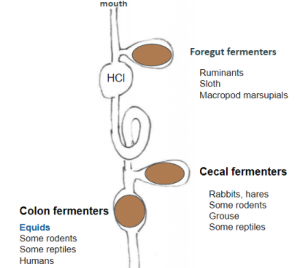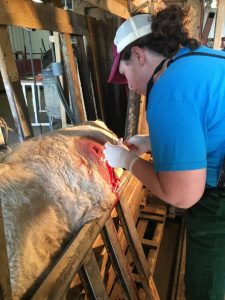26 Fermentation
Fermentation chambers can occur in several different locations in mammalian gastrointestinal tracts.

Each of us has a unique microbiome that is essential for our good health. The microbes digest any starches and proteins in the chyme, including those in sloughed intestinal cells. In all species, a healthy microbiome also produces enough water soluble B vitamins and vitamin K to keep us healthy. Additionally, our microbiomes also include other microbes that are less helpful and may be harmful but these are typically in small numbers.
Microbes generally have a preferred milieu. If that environment is changed, different microbes can take over and change the level of nutrient and gas production. For instance, if any of us eat too much, the extra food will reach the microbes in our colon. This may lead to changes in pH and type of microorganisms that thrive in the new pH. At the very least, it will lead to increased intestinal gas. Happy microbes produce gas as a byproduct (think about those fermented drinks, including beer).
However, none of us have microbes when we are born. We acquire microbes through a variety of processes. Colonization of our intestines with microbes often starts during the birth process and with organisms from the vaginal canal as well as from the dam’s skin. Foal heat diarrhea is believed to be related to foal coprophagy (eating feces); the coprophagy is useful to digest those microbes but leads to the mild diarrhea until the GI tract can adjust.
As a juvenile switches from milk to other diets, the microbial environment becomes more important. Often there is a slight mismatch between the microbiome maturity and the diet. In calves, this mismatch can lead to free gas bloat. This type of “immaturity” bloat can be a recurrent issue, necessitating the placement of a relief valve in the rumen to let the gas off. Ideally, calves with recurrent free gas bloat get a “rumenostomy” (surgical opening into the rumen) that allows gas to escape when needed, at least until the rumen flora mature.

Roles of the microbes
- Normal flora help keep out the pathogenic (harmful) organisms
- antibiotics can alter the normal flora and allow more destructive bacteria to take up residence
- Normal flora help maintain gut health
- by nourishing the colonic cells, bacteria support gut mucus production by the goblet cells
- the mucus helps protect the gut wall
- Normal flora stimulate the immune system and support the immune response
- Normal flora provide Vitamin B1 (thiamine), B2 (riboflavin), B12 (cobalamin) and Vitamin K
- these are required for good neuronal health, many metabolic functions, red blood cell formation and normal clotting
- water soluble vitamins are not stored so need to be constantly provided by the diet or microbes
- Normal flora feed the ruminant
- we don’t really feed the cow; we feed the bugs (the microbiome) and the bugs feed the cow
- microbes convert protein into microbial growth, ammonia, and gas. The ammonia goes through the urea cycle to be turned into protein for the cow. The microbes also turn into protein when they die
- microbes convert fat into microbial growth. Bypass fat can also be fed to the ruminant; this fat is absorbed in the small intestine as it would be in dogs
- microbes convert the cellulose compounds into energy in the form of volatile fatty acids (propionate, butyrate and acetate)
- acetate and butyrate are formed into ketone bodies and can be mobilized when needed
- propionate can be converted directly into glucose
In non-fermenters, the microbes still do the first four items on the list!
Foregut fermenters
Ruminants and other foregut fermenters (i.e. camelids) need the microbes to produce cellulase. Cellulase breaks down grasses into compounds that microbes can digest. The microbes transform food into essential B vitamins and one of three volatile fatty acids (VFAs)- acetic acid, proprionic acid acid and/or butyric acid.
Ratios of VFAs vary by diet and microbe population. The VFAs are absorbed through the rumen wall and transported to the liver and other parts of the body. The liver can convert propionic acid into glucose; the other acids are used by various other cells of the body (especially by the udder). VFAs provide 60-80% of the cow’s energy, meaning a healthy microbial flora is essential.
Microbes also digest protein and are a source of (microbial) protein. Once the microbes are killed in the abomasum, the protein is digested and absorbed by the ruminant.
In the rumen, the best pH for the helpful microbes is about 6. That balances the needs of both fiber and starch digesting organisms. If that is altered, some other microbes may be happier than they should be. That can change the pH and lead to death of the normal microbes and overgrowth of bad bacteria.
Try this
Research beer making. Microbes are involved – how so? How does the pH alter the beer production? How does the beer production environment resemble rumen fermentation?
Hindgut fermenters- cecal and colonic
The equine large colon has been highly modified to allow cellulose digestion. It is very elongated to allow maximal exposure of the cellulose products to the microbes. Activity is largely mixing with propulsion slowed to keep the ingesta in the colon for long periods of time (transit time is 30-50h). This maximizes the nutrition that the horse can obtain from the hay diet. The microbes use the hay (and any leftover carbohydrates) for energy and produce volatile fatty acids that are absorbed by the colon wall and used by the horse. These fatty acids supply the major portion of the horse’s daily energy requirements and is why they do well on a strictly hay diet. The microbes also produce some essential B vitamins. Unlike in foregut fermenters, the hindgut fermenters can’t use the microbial protein unless they eat feces. Horses do not routinely eat their own feces, so their protein needs are met by the food they ingest.
The colon also buffers ingesta coming from cecum and absorbs fluid from the ingesta. A pony resorbs approximately 30 liters of fluid/day from the colon.
As with the small intestine, the colon (with its microbes) is designed to handle frequent eating and continuous flow of ingesta. If horses are fed only twice daily, they will have much more extensive fluid shifts into the ingesta and out of the colon, particularly if they are fed highly fermentable carbohydrates. Increasing carbohydrates entering the cecum and colon also means happy microbes and more gas production.
Rabbits are a cecal fermenter. The digestion process requires a repeat exposure to the feed for full digestion. Similar to birds with retroperistalsis activity, once through the gut is not enough. Rabbits eat the “night feces” (coprophagy) which are rich in dietary essentials produced by the microorganisms and partially digested cellulose. This permits those nutrients to be removed by the rabbits GI tract when they go back through the small intestine.
Probiotics and prebiotics
Sometimes the microbes need a boost. This can happen with either probiotics (more microbes) or prebiotics (microbial food stuff). Probiotics are used to help the microbiome when it is not healthy. This often happens with illness and/or antibiotic therapy. Antibiotics often kill the microbiome as well as any infection we are battling.
One of the most common prebiotics is psyllium. Psyllium is added to intestinal diets to help support the microbes.
Key Takeaways
- Microbes are responsible for fermentation. They require very specific environments to thrive (eg rumen pH of ~6). In exchange, they provide immune support, inhibit the invasion of pathogenic microbes, supply essential B vitamins, support intestinal cells, and provide nutrition to their host.
- Microbes produce ammonia (nitrogen /protein source) and volatile fatty acids. Acetate and butyrate are formed into ketone bodies for energy storage while propionate can also be used for milk sugars. The dead microbes also serve as a protein source.
- Pre-ruminant calves have not yet started chewing cud. While on a milk diet, the esophageal groove keeps milk out of the rumen. Later, hays and grains develop the rumen papillae.
- Some hindgut fermenters re-ingest their feces in order to fully access the microbial products.
Resources
Life sciences lecture – UIll
Rumen physiology and rumination – CSU
Rumen development in the dairy calf – Dairexnet
Ruminant structure and function – nice overview
Rabbit coprophagy explanation
More depth
Feeding the calf – Calf care canada
Calf nutrition and management – free coursera lecture
Rumen development and weaning in dairy calves– good images
Rabbit cecal function – not sure about the secretion part but interesting article
Probiotics and prebiotics – World Gastroenterology Society report
Ingesta mixed with salivary and gastric juices
Foals often have diarrhea the first time their.dam goes through her heat cycle. A heat cycle is similar to a menstrual cycle in women.
formulations of fat that are designed to pass by the rumen without being eaten by microbes and go to the intestines for digestion

